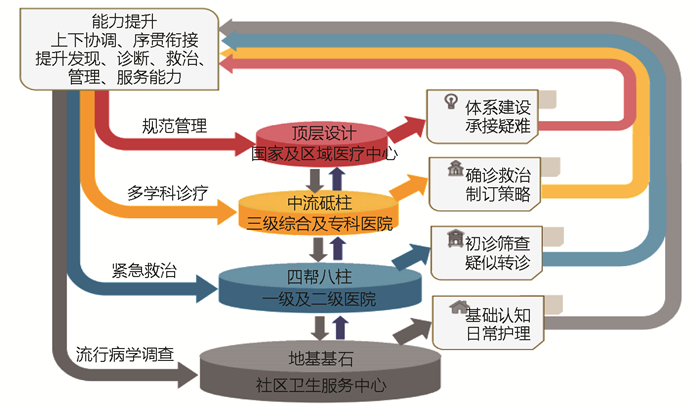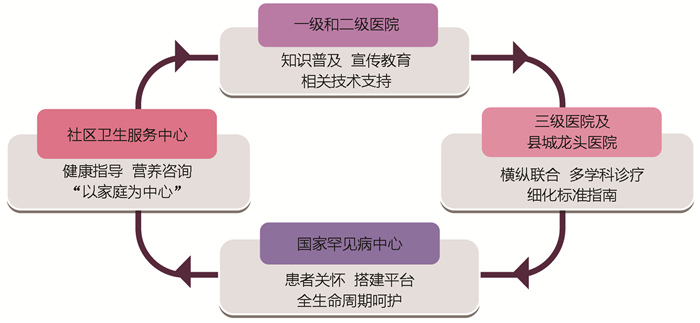-
摘要: 儿童罕见病,并无标准定义,可以被理解为儿童时期发病的罕见病,亦或罕见病患者的儿童时期。具有患病率低、临床罕见、种类繁多、难诊难治的特点。近年来,随着医学事业的高速发展,罕见病管理体系的建立及推广,罕见病的诊断技术和治疗手段取得较大进步,罕见病管理保障得到逐步拓展与完善,但仍面临着挑战与机遇。中国幅员辽阔,各层级医疗资源不对称,对许多罕见病的发病机制认识受限,检测手段参差不齐,诊疗能力存在差异,大多数罕见病仍被误诊或长期漏诊。因此,从罕见病层级管理手段入手,进行合理分流、危险分层、早期诊断、科学救治,着眼整合区域诊疗管理体制建设尤为重要。有多项研究证实罕见病发生存在一定遗传异质性,半数以上于出生时或儿童期发病,死亡率高,存活患者多有功能残障等。因此,儿童期发病的罕见病更应引起医药卫生领域的高度重视,儿童罕见病的规范化、制度化、法制化管理亟待推进。本文主要探讨儿童罕见病管理现状,总结目前儿童罕见病的临床进展,并对未来前景做出展望,以期为儿童罕见病的管理提供一定的参考意见。Abstract: There is uniformed definition of rare diseases in children, which can be viewed as rare diseases that develop in childhood, or the childhood of patients with rare diseases. Rare diseases are rarely seen in clinical setting, various in types and difficult to diagnose and treat. In the past few years, with the rapid development of medical technology and the establishment and wide application of rare disease management systems, great progress has been made in the diagnosis and treatment of rare diseases. Although the management of rare diseases is being gradually expanded and enhanced, there are still challenges, or opportunities for further improvement. China is a vast country with imbalanced distribution of medical resources. In many places, people have limited knowledge about the pathogenesis of many rare diseases. Capacities vary in the detection, diagnosis, and treatment of rare disease in different places. As a result, most rare diseases are either misdiagnosed or not diagnosed at all. Therefore, it is of great significance to establish a hierarchical system for the management of rare diseases, i.e., appropriate triage, risk stratification, early diagnosis and scientific treatment, and integrate regional resources into rare disease management. Studies have confirmed the existance of heterogeneity of rare diseases, with more than half of them occurring at birth or in childhood and that they are associated with a high mortality rate and a high incidence of functional disabilities in survivors. Therefore, rare diseases in child-ren deserve more attention. Standardized, protocol-based, law-based management of rare diseases in children is in urgent need. The article aims to discuss the status quo of the management of rare diseases in children, to summarize the clinical progress of rare diseases in children and to explore its prospects in the future, in the hope to provide some reference for the management of rare diseases in children.
-
Keywords:
- children /
- rare diseases /
- management
-

张抒扬
北京协和医院 院长
《罕见病研究》 主编
金牛奋蹄辞旧岁,寅虎飞跃报春来!在2022年新春到来之际,《罕见病研究》杂志正式创刊出版,与广大读者见面了。
罕见病的早期诊断、治疗与管理,一直是世界范围内的医学难题。罕见病的单病种发病率低,但病种繁多、总体患者数量庞大,且诊疗难度大、漏诊误诊率高,多数威胁患者生命,给患者和社会带来沉重负担。近年来,在党和政府的大力支持下,我国正在积极探索破解罕见病防治难题的“中国模式”。各部门通力合作,加强政策研究和制度建设,制定罕见病目录、建立罕见病诊疗与保障专家委员会,组织推出罕见病目录释义、罕见病诊疗指南等系列指导文件,建立全国罕见病诊疗协作网,强化区域协作和远程支持,形成强大工作合力,取得了一系列令人欣喜的显著进展。
深入开展罕见病研究,是面向国家医学科技进步重大需求、推动和引领医学科技创新的重要举措,也是增进罕见病患者健康福祉、落实健康中国战略的必然要求。在国家新闻出版署和国家卫生健康委员会的支持指导下,北京协和医院牵头,汇聚全国从事罕见病预防、诊断、治疗和政策研究的专家学者,携手创办《罕见病研究》杂志。这是我国罕见病研究领域的里程碑事件,标志着我国罕见病防治事业迈上了新的台阶。
《罕见病研究》杂志作为我国罕见病研究领域的重要窗口和学术交流平台,将追踪国际罕见病领域研究前沿,聚焦罕见病诊治中迫切需要解决的难题,及时报道罕见病基础和临床研究、孤儿药研发的新动态、新进展和新成果,全方位多角度解读罕见病相关政策法规,详实记录我国罕见病诊疗发展的足迹,积极推动医疗人员、药学研究者、政策管理者和患者之间的沟通和交流,助力我国罕见病诊治保障能力不断提升。本刊开设述评、专家笔谈、论著、病例报道、综述、指南与共识、多学科病例讨论、影像专栏、孤儿药专栏、诊疗资讯等栏目,内容涵盖基础医学、临床医学、药学、转化医学和医学伦理学等多个方面,欢迎广大业界同仁踊跃发表真知灼见。
承载希望,超越梦想。让我们踔厉奋发、笃行不怠,用救苦之心和医者仁术履行对健康的承诺,关爱每一个生而不凡的生命!

2022年1月
作者贡献:刘薇主持并设计选题,审阅论文中关键性理论,原创图片。刘薇、张碧丽与黄金月共同参与文献检索、分析、撰写及修改论文。利益冲突:所有作者均声明不存在利益冲突 -
[1] Nestler-Parr S, Korchagina D, Toumi M, et al. Challenges in research and health technology assessment of rare disease technologies: report of the ISPOR rare Disease special interest group[J]. Value Health, 2018, 21: 493-500. doi: 10.1016/j.jval.2018.03.004
[2] 张抒扬. 关爱罕见病, 从保障用药开始[J]. 中国卫生, 2019, 5: 2. https://www.cnki.com.cn/Article/CJFDTOTAL-WSZG201905031.htm [3] Haijes HA, Molema F, Langeveld M, et al. Retrospective evaluation of the Dutch pre-newborn screening cohort for propionic acidemia and isolated methylmalonic acidemia: what to aim, expect, and evaluate from newborn screening?[J]. J Inherit Metab Dis, 2020, 43: 424-437. doi: 10.1002/jimd.12193
[4] 李定国, 王琳, 许小幸. 从临床流行病学角度思考中国罕见病定义修订[J]. 临床儿科杂志, 2021, 39: 561-564. doi: 10.3969/j.issn.1000-3606.2021.08.001 [5] 邵文斌, 李杨阳, 王菲, 等. 中国罕见病药品可及性现状及解决建议[J]. 中国食品药品监管, 2019, 2: 8-15. https://www.cnki.com.cn/Article/CJFDTOTAL-YPJD201902004.htm [6] 澎湃, 许雯. 首批国家版罕见病目录发布[J]. 人民周刊, 2018, 12: 2. https://www.cnki.com.cn/Article/CJFDTOTAL-RMWZ201812014.htm [7] 国家卫健委网站. 国家卫健委发文建立全国罕见病诊疗协作网, 信息化支撑不可或缺[J]. 医学信息学杂志, 2019, 40: 1. https://www.cnki.com.cn/Article/CJFDTOTAL-YXQB201902022.htm [8] 国家卫生健康委官网. 国家卫健委: 完成我国首部罕见病诊疗指南发布[J]. 中华医学信息导报, 2019, 34: 1. https://www.cnki.com.cn/Article/CJFDTOTAL-QBZZ202111015.htm [9] 潘锋. 医生是实现移动医疗的关键——访国家老年疾病临床医学研究中心主任陈彪教授[J]. 中国医药导报, 2019, 16: 3. https://www.cnki.com.cn/Article/CJFDTOTAL-YYCY201914001.htm [10] 贺彩红, 蒋琬姿, 张丽雯, 等. 罕见病领域研究现状与趋势分析[J]. 遗传, 2021, 43: 531-544. doi: 10.3760/cma.j.cn511374-20200422-00294 [11] Colla P, Hellowell M, Vecchi V, et al. Determinants of the cost of capital for privately financed hospital projects in the UK[J]. Health Policy, 2015, 119: 1442-1449. doi: 10.1016/j.healthpol.2015.08.018
[12] Benjamin K, Vernon MK, Patrick DL, et al. Patient-reported outcome and observer-reported outcome assessment in rare disease clinical trials: an ISPOR COA emerging good practices task force report[J]. Value Health, 2017, 20: 838-855. doi: 10.1016/j.jval.2017.05.015
[13] Wolfgang A, Greiser KH, Jakob L, et al. The investigation of health outcomes in the German National Cohort: the most relevant endpoints and their assessment[J]. Bundesgesundheitsblatt, Gesundheitsforschung, Gesundheitsschutz, 2020, 63: 376-384. doi: 10.1007/s00103-020-03111-0
[14] Taruscio D, Gentile AE, Santis M De, et al. EUROPLAN: a project to support the development of national plans on rare diseases in Europe[J]. Public Health Genomics, 2013, 16: 278-87. doi: 10.1159/000355932
[15] Valan AS. Ministry of health and family welfare government of india, national guidelines for infection prevention and control in healthcare facilities[M]. 2020, 25-27.
[16] Melo DG, de Paula PK, de Araujo Rodrigues S, et al. Genetics in primary health care and the national policy on comprehensive care for people with rare dseases in brazil: opportunities and challenges for professional education[J]. J Community Genet, 2015, 3: 231-240. http://pubmedcentralcanada.ca/pmcc/articles/PMC4524835/
[17] Boycott KM, Hartley T, Biesecker LG, et al. A Diagnosis for All Rare Genetic Diseases: The Horizon and the Next Frontiers[J]. Cell, 2019, 177: 32-37. doi: 10.1016/j.cell.2019.02.040
[18] 任晓星, 史录文. 中美欧新药上市加快审评审批政策研究[J]. 中国新药杂志, 2020, 29: 961-971. doi: 10.3969/j.issn.1003-3734.2020.09.001 [19] Xin X, Guan X, Shi L. Catastrophic expenditure and impoverishment of patients affected by 7 rare diseases in China[J]. Orphanet J Rare Dis, 2016, 11: 74 doi: 10.1186/s13023-016-0454-7
[20] Gong S, Wang Y, Pan X, et al. The availability and affordability of orphan drugs for rare diseases in China[J]. Orphanet J Rare Dis, 2016, 11: 20. doi: 10.1186/s13023-016-0392-4
[21] 张抒扬, 赵玉沛. 罕见病学[M]. 北京: 人民卫生出版社, 2020: 1-12. [22] 尚越, 常精华, 宋海. 唐山市临床医生罕见病诊疗行为影响因素分析[J]. 医学与社会, 2021, 34: 57-61. https://www.cnki.com.cn/Article/CJFDTOTAL-YXSH202108012.htm [23] 程俊, 高华斌, 何梅. 罕见病医疗保障现状及问题研究——以某医院收治的3个罕见病种为例[J]. 卫生软科学, 2021, 35: 21-26. https://www.cnki.com.cn/Article/CJFDTOTAL-WRKX202109005.htm [24] 郁婷婷, 傅启华. 罕见病诊治思考与展望[J]. 检验医学, 2021, 36: 119-121. https://www.cnki.com.cn/Article/CJFDTOTAL-SHYY202102001.htm [25] 刘薇, 李定国, 张碧丽, 等. 儿童罕见病诊疗与管理[M]. 北京: 人民卫生出版社, 2021: 1-5. [26] 戴国琳, 刘新遥, 陈荃, 等. 罕见病专题地图的设计[J]. 中国全科医学, 2021, 24: 3643-3647. https://www.cnki.com.cn/Article/CJFDTOTAL-QKYX202128018.htm

 作者投稿
作者投稿 专家审稿
专家审稿 编辑办公
编辑办公 主编办公
主编办公


 下载:
下载:




